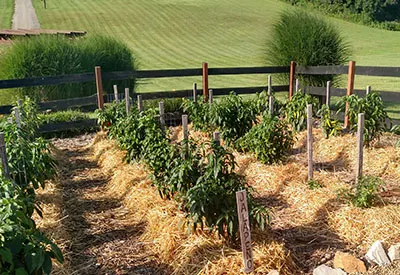If there is one simple secret that can make all the difference in growing a productive, low maintenance, high producing, weed free vegetable garden – it is using mulch. But even of more importance – its about using the right type of mulch in the right spaces of the garden. And when that occurs, great gardens happen!

Utilizing the right mulch in the garden unleashes a whole host of powerful and time-saving benefits. And those benefits only get better every year.
First off, garden mulch is an incredible weed suppressor. Used correctly, mulch eliminates nearly all of your weeding chores over time.
Using a variety of low-cost mulches in the various areas or “zones” of our Raised Row Garden, we have reduced weeding chores to mere minutes a day. But the short and long-term benefits of garden mulch go well beyond just eliminating weeds.
Mulch is fantastic in keeping the soil around a plant’s root system warmer during cool early spring, and late fall days. At the same time, it keeps the soil cooler during the hot and humid “dog days” of summertime. Mulching also helps keep consistent moisture in the soil. Together, soil temperature and consistent moisture levels are two of the biggest keys in keeping vegetable plants stress-free. And stress free plants produce!
But perhaps best of all, as it breaks down, mulch can replenish incredible amounts of nutrients back into the soil of your growing rows. Nutrients that plants need and use to produce a big harvest.
Using The Right Mulch – Creating A Weed Free Vegetable Garden
Most people correlate mulch with the bagged landscape varieties sold at what now seems like every street corner store in America. But that is not the mulch we are talking about to power a garden. And it doesn’t have to be expensive.

The truth is, when it comes to a garden, there are many types of mulch varieties you can use that will work wonders. It comes down to where and how you use them.
There are 3 basic mulch zones in the garden. They include walking zones, growing row zones, and the planting zones. Although each mulch zone serves a different purpose, all are of equal importance to the overall success and ease of maintenance of your garden. Each zone has it’s own unique requirement when it comes to the type of mulch that can be used.
One of our favorite chapters in our new Raised Row Gardening book covers the process of mulch in-depth, including a multitude of inexpensive choices to power each of those zones. For instance, in the walking rows, almost any inexpensive and weed suppressing mulch can be used to eliminate garden chores.
The soil in this space will never be worked – so it can be covered with cheap or nearly free by-products like wood chips, straw, sawdust, or even cardboard and newspaper. The key is to mulch it off so you never have to worry about maintaining it. Once done, there is never a need to maintain this space – eliminating 80% of a typical garden chores.
But when it comes to the growing and planting zones, mulch choices needs to lean toward the power and energy side. Using mulch up and around plants such as compost, grass clippings and shredded leaves not only protect plants and suppress weeds, but they power the plants and soil as they break down. The combination of mulches leads to an amazingly productive and care free garden. And one that will have you signing the joys of gardening!
You can find more in-depth information on mulch, natural fertilizers and more in our new book Raised Row Gardening. It also includes our comprehensive planting guide, with step by step planting instructions for nearly any vegetable you can think of! Product Link : Raised Row Gardening
Here is to using mulch for a weed-free vegetable garden this year and for years to come!
Jim and Mary
To receive our 3 Home, Garden, Recipe and Simple Life articles each week, sign up for our free email list. You can also follow us on Facebook, Twitter, Pinterest, or Instagram. This article may contain affiliate links.

